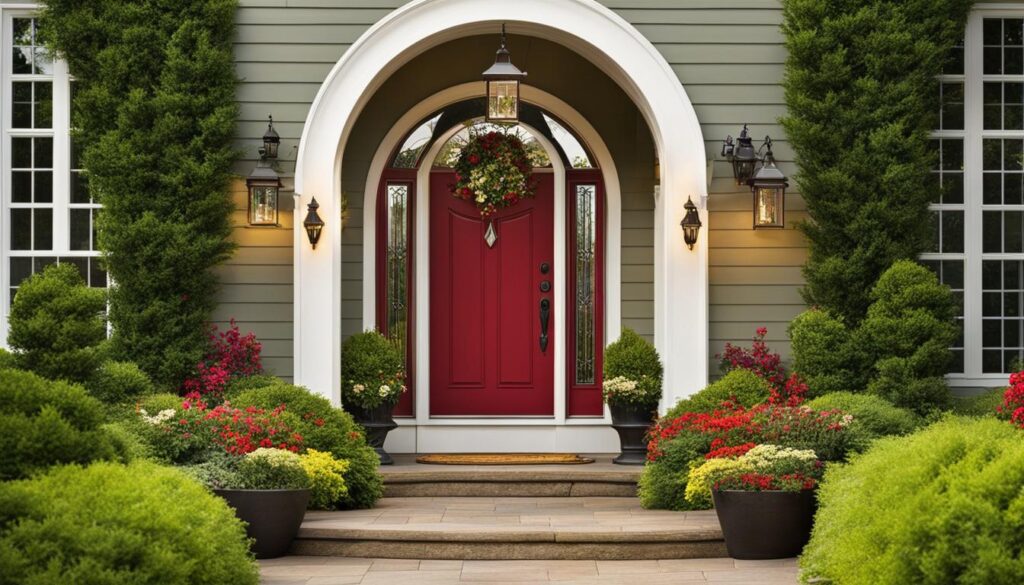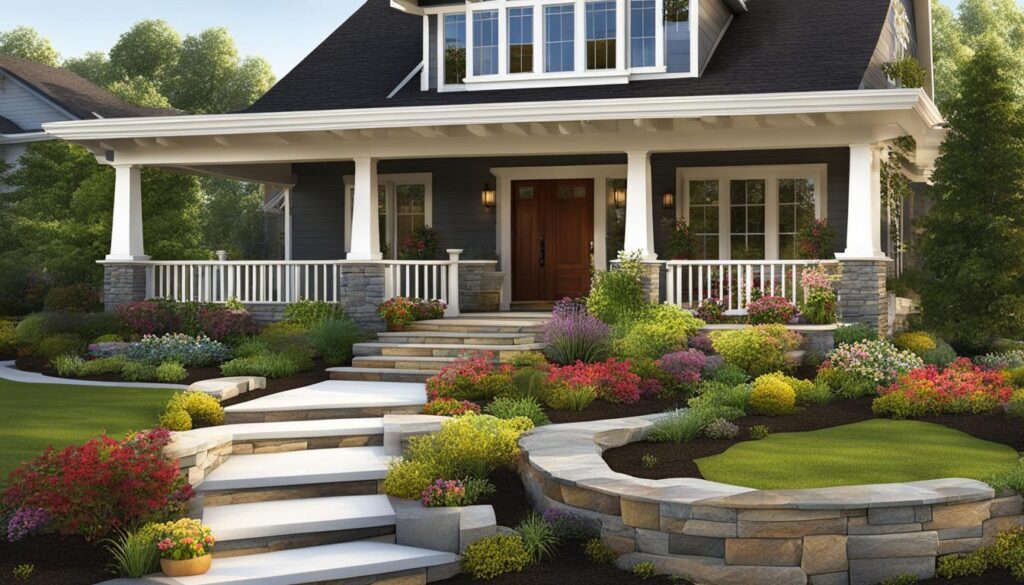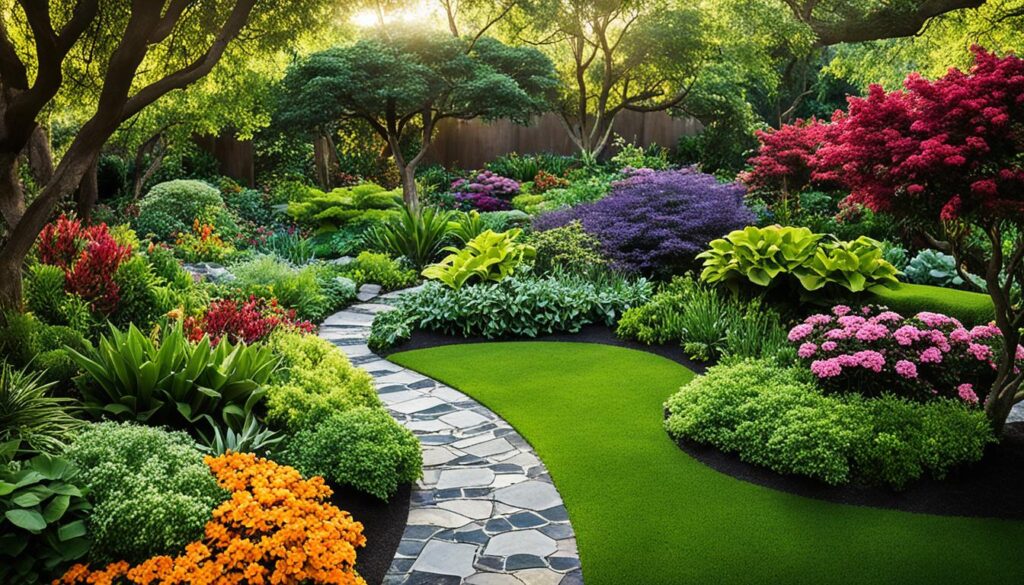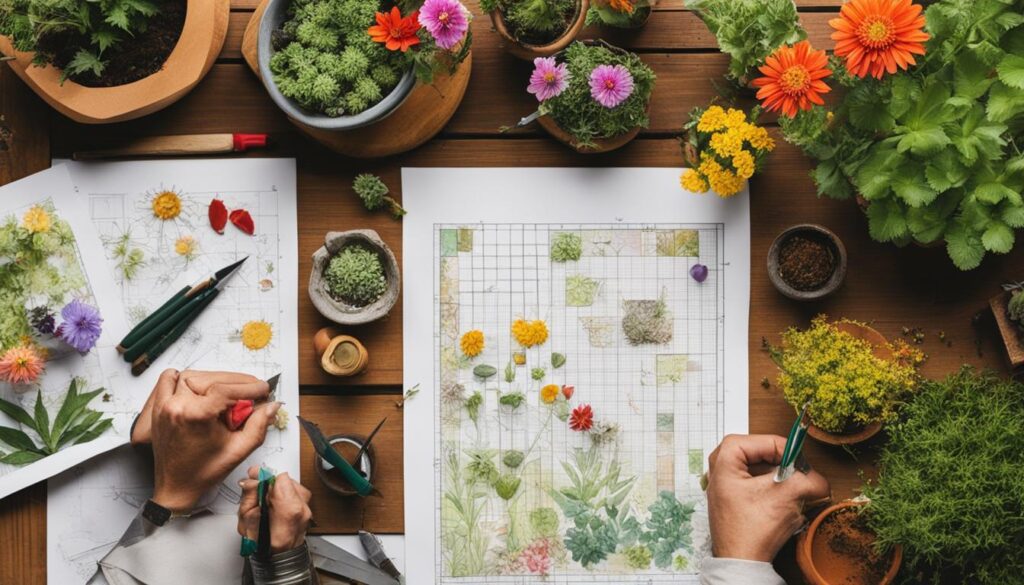Garden design is key to enhancing the curb appeal of your home and creating a beautiful outdoor space. Whether you’re planning a new garden layout or refreshing an existing one, there are plenty of ideas and tips to inspire you. By incorporating the principles of landscape design and considering your specific goals and priorities, you can transform your front yard into a stunning and inviting space.
When it comes to garden planning, there are several key factors to consider. From choosing the right plants for your climate and soil conditions to creating a balanced and harmonious layout, every element plays a role in achieving the desired aesthetic. By applying proven garden design tips and exploring different styles and features, you can create a unique and beautiful garden that complements your home’s architecture and reflects your personal style.
Whether you prefer a minimalist garden with clean lines and simple shapes or a lush and vibrant landscape filled with colorful flowers and foliage, the possibilities are endless. With careful consideration of design principles and attention to detail, you can create stunning layouts that maximize curb appeal and make a lasting impression.
Key Takeaways:
- Creating stunning garden layouts is essential for maximizing curb appeal.
- Consider your home’s design and architecture when planning your garden.
- Choose plants and features that complement your house’s style.
- Focus on creating welcoming walkways and entryways to enhance curb appeal.
- Explore low-maintenance options for easy upkeep.
The Importance of House Design in Curb Appeal Landscaping
When it comes to creating curb appeal, the design and architecture of your home play a crucial role. The style of your landscape should complement the design of your house, resulting in an overall aesthetic that is visually pleasing and harmonious. Whether you have a traditional or modern home, there are specific landscaping styles that perfectly enhance the beauty of your front yard.
Cottage-Style Landscape for a Charming Country Look
If you have a country or farmhouse-style home, a cottage-style landscape is an ideal choice. This landscaping style features lush flowerbeds, a mix of vibrant colors, and a variety of plants and flowers that give a romantic and charming feel to your front yard. Delicate roses, daisies, and climbing vines can add a touch of natural beauty to the exterior of your home.
Minimalist Garden for a Modern Touch
For those with a modern home, a minimalist garden is the perfect complement. This style emphasizes clean lines, simplicity, and the use of fewer plants and elements. Opt for low-maintenance plants like succulents, ornamental grasses, and evergreen shrubs to achieve a sleek and contemporary look. Incorporate geometric shapes and hardscaping elements, such as concrete pavers or gravel pathways, to add structure and visual interest to your front yard.
By choosing plants and features that align with the style, shape, and size of your house, you can create a cohesive and visually appealing curb appeal. Consider the architectural elements of your home and let them guide your landscaping choices. Remember, a well-designed and thoughtfully curated front yard can make a lasting impression and increase the overall value of your property.
Creating Welcoming Walkways and Entryways
An inviting walkway leading to the front door is essential for improving Landscaping Curb Appeal. It sets the tone for your home and creates a warm and welcoming atmosphere for guests. To enhance the front door transition, consider incorporating a walkway bend or curve. This not only adds visual interest but also guides guests intuitively to the front entrance.

Along the walkway, adding planters on either side can further enhance the curb appeal. Outdoor planters filled with vibrant flowers or greenery create a beautiful focal point and add color and texture to the overall design.
When choosing plants for your walkway, it’s essential to consider color coordination with your house. By selecting plants that complement the color of your home, you can create a harmonious and cohesive look. For example, if you have a blue house, purple, pink, yellow, and white flowers can create a stunning contrast.
Bold Plant Choices for Color Coordination
- Purple petunias
- Pink roses
- Yellow daisies
- White hydrangeas
Utilizing large shapes and masses of plants that are attractive from a distance also anchors the overall design and contributes to the curb appeal. However, it’s crucial to ensure that these plants do not obstruct windows or doors, maintaining the functionality of your entryway.
By carefully considering the design of your walkways and entryways, you can create a visually appealing and welcoming Landscaping Curb Appeal that leaves a lasting impression on visitors.
Low-Maintenance Garden Design Tips
When it comes to creating a stunning garden, not everyone has the time or desire to maintain an elaborate landscape. That’s why incorporating low-maintenance design elements can be a game-changer, especially if you’re planning to sell your home. By choosing plants that require minimal care and don’t create excessive litter, you can achieve a beautiful garden without the hassle.
Petunias are a fantastic choice for low-maintenance gardens. These vibrant flowers come in various colors and thrive in both containers and garden beds. They require minimal pruning and deadheading, making them an ideal option for those who want a pop of color without the constant upkeep.
Another key element of low-maintenance garden design is incorporating shrubs. These versatile plants offer year-round structure and require minimal care. Choose varieties that suit your climate and space, ensuring they don’t outgrow their designated area. Examples of low-maintenance shrubs include boxwoods, yews, and spireas.
Additionally, integrating groundcover plants into your garden can reduce maintenance while adding beauty to your yard. Groundcovers not only fill in empty spaces but also help prevent weed growth and erosion. Opt for varieties that provide structure and remain appealing throughout the year, even in the winter season.
Creating a low-maintenance garden allows you to enjoy the beauty of nature without dedicating excessive time and effort. By selecting petunias, incorporating shrubs, and utilizing groundcover plants, you can achieve a visually stunning garden that requires minimal maintenance.
Key Points:
- Choose low-maintenance plants like petunias for vibrant color without constant upkeep.
- Incorporate shrubs that provide year-round structure and require minimal care, such as boxwoods and yews.
- Utilize groundcover plants to reduce maintenance and add beauty to your yard.
Low-Maintenance Plants
| Plant | Description |
|---|---|
| Petunias | Vibrant flowers in various colors, require minimal pruning and deadheading. |
| Boxwoods | Evergreen shrubs with dense foliage, provide year-round structure. |
| Yews | Slow-growing evergreen shrubs, require minimal care and add texture to the garden. |
| Groundcover Plants | Low-growing plants that fill in empty spaces, reduce maintenance, and prevent weed growth. |
Enhancing Curb Appeal with Additional Elements
When it comes to curb appeal, the exterior of your home is just as important as the landscaping. To truly elevate the visual appeal of your property, consider adding additional garden elements, upgrading the exterior, refreshing the entryway, and enhancing the front door hardware. These small yet impactful changes can make a significant difference in creating an inviting and charming atmosphere.
Outdoor Seating Areas and Benches
One way to enhance your outdoor space is to create inviting seating areas. Consider adding benches or outdoor furniture where you, your family, and guests can relax and enjoy the surroundings. Not only does this add functionality to your yard, but it also creates a welcoming atmosphere that instantly boosts curb appeal.
Accent Features: Water Fountains and Garden Sculptures
To add a touch of elegance and visual interest, incorporate accent features like water fountains or garden sculptures. These eye-catching elements become focal points in your landscaping, drawing attention and creating a sense of sophistication. Choose pieces that complement the style and theme of your garden to create a cohesive look.
Front Door Hardware
Updating the front door hardware is a simple yet effective way to elevate your home’s curb appeal. Consider replacing outdated handles, locks, and knockers with stylish and modern options. Choose hardware that complements the architectural style of your home and adds a touch of personality.
Refreshing House Paint Colors
A fresh coat of paint can instantly transform the look of your home. Consider refreshing the house paint colors to create a striking first impression. Choose colors that complement the overall design and landscaping, creating a cohesive and visually appealing exterior.

By incorporating these additional elements, you can enhance curb appeal and create a welcoming atmosphere that reflects your personal style. These small upgrades and attention to detail can make a lasting impression on visitors and potential buyers, increasing the overall value of your property.
The Basics of Garden Design for Beginners
Garden design is not just about creating a visually appealing outdoor space; it also has significant mental and physical health benefits. By understanding the fundamentals of garden design and following essential tips and tricks, you can transform your outdoor space into a tranquil and beautiful sanctuary.
Creating an Outdoor Space
Designing a garden allows you to create a personalized outdoor space that meets your needs and reflects your unique style. Whether you have a small balcony or a spacious backyard, there are endless possibilities to explore. A well-designed garden provides you with a space to relax, unwind, and connect with nature.

Mental and Physical Health Benefits
Spending time in a well-designed garden can have a positive impact on your mental and physical well-being. It offers an opportunity to reduce stress, enhance creativity, and improve overall mood. The presence of plants and greenery in your outdoor space promotes relaxation and provides a sense of tranquility.
In addition, gardening itself is a physical activity that can improve cardiovascular health, increase flexibility, and strengthen muscles. It is also a great way to incorporate more movement into your daily routine and enjoy the benefits of being outdoors.
Essential Tips and Tricks
Here are some essential tips and tricks to consider when designing your garden:
- Start by conducting a thorough site analysis, considering factors such as sunlight exposure, soil quality, and existing features.
- Identify your goals and priorities for the garden. Do you want a space for relaxation, entertaining guests, or growing your own vegetables?
- Choose plants that are appropriate for your climate and site conditions. Consider factors such as water requirements, maintenance needs, and seasonal changes.
- Create a focal point in your garden, whether it’s a stunning plant, a unique sculpture, or a decorative feature.
- Consider incorporating different textures, colors, and heights to add visual interest and depth to your garden.
- Don’t forget about hardscaping elements such as pathways, seating areas, and garden structures. These features provide structure and organization to your outdoor space.
“Gardening is the art that uses flowers and plants as paint and the soil and sky as canvas.” – Elizabeth Murray
By following these garden design basics, you can create a beautiful outdoor space that not only enhances the visual appeal of your home but also provides you with mental and physical health benefits. Get started on your garden design journey and discover the joy and tranquility that gardening can bring.
Planning Your Garden Design
Before embarking on your garden design journey, it’s crucial to conduct a thorough site analysis. This assessment will provide valuable insights into key factors that will influence your design decisions, such as sunlight exposure and soil quality. By understanding the unique characteristics of your garden site, you can make informed choices and create a thriving outdoor space.
When conducting a site analysis, consider the following:
- Sunlight Exposure: Observe how sunlight interacts with different areas of your garden throughout the day. This will help you identify areas of full sun, partial shade, or full shade, allowing you to choose appropriate plants accordingly.
- Soil Quality: Test the soil’s composition and fertility. Factors such as drainage, pH levels, and nutrient content can significantly impact plant growth. By understanding your soil’s characteristics, you can select plants that will thrive in its specific conditions.
Once you have completed the site analysis, it’s time to define your goals and priorities for the garden. Consider your lifestyle, preferences, and the purpose of the outdoor space. Do you want a low-maintenance garden that requires minimal upkeep? Are you aiming for a specific theme or style?
Remember, a well-designed garden reflects your unique vision and meets your specific needs.
Having clear goals and priorities will guide your plant selection, layout choices, and design features. It will ensure that your garden aligns with your vision and creates a space that you and your family can enjoy for years to come.
By conducting a site analysis and defining your goals and priorities, you lay a solid foundation for a successful garden design. This preparation will enable you to choose the right plants, design elements, and layout that suit your site’s conditions and fulfill your vision.

Designing Your Garden
When it comes to designing your garden, there are several key principles to keep in mind. These principles, such as balance, proportion, unity, rhythm, and focalization, serve as the foundation for creating a visually appealing and functional outdoor space that reflects your personal style.
Balance: Achieving balance in your garden involves distributing visual weight evenly throughout the space. Consider both the size and placement of plants, garden features, and hardscaping elements to create a harmonious layout.
Proportion: Proportion relates to the size and scale of different elements within your garden. Ensure that the size of plants, pathways, seating areas, and other features are proportionate to the overall size of the space. This creates a sense of harmony and prevents any one element from overpowering the rest.
Unity: Creating unity in your garden involves ensuring that all elements work together cohesively. Choose plants, garden features, and hardscaping materials that complement one another and fit within a consistent theme or style.
Rhythm: Rhythm in garden design refers to the repetition and progression of visual elements. Use repetition of plants, colors, and textures to create a sense of rhythm and flow throughout your garden. Consider incorporating pathways or borders to guide the eye and create a pleasing visual rhythm.
Focalization: Focalization helps draw attention to specific areas or elements within your garden. Select a focal point, such as a stunning plant, sculpture, or water feature, and arrange other elements around it to enhance its impact.
These principles should guide your choices when selecting plants, deciding on the layout of pathways and seating areas, and incorporating hardscaping elements such as retaining walls or garden structures.
To help visualize these design principles in action, take a look at the example garden layout below:
| Element | Description |
|---|---|
| Pathways | Curved pathways create a natural flow and guide visitors through the garden. |
| Seating Areas | Multiple seating areas provide space for relaxation and enjoyment of different garden views. |
| Hardscaping | Stone retaining walls and a pergola add structure and visual interest to the garden. |
| Garden Features | A water fountain and decorative urns serve as focal points, adding charm and elegance. |
By incorporating these design principles into your garden layout, you can create a visually stunning and inviting outdoor space that enhances the overall aesthetic of your home. Embrace your creativity and personal style to design a garden that brings you joy and reflects your unique personality.
Conclusion
Creating optimal curb appeal through well-designed landscaping projects is the key to transforming your outdoor space into a visually stunning and inviting area. By incorporating hardscaping elements such as pathways, outdoor seating areas, and focal points, you can enhance the overall aesthetic and functionality of your front yard.
One important aspect to consider is symmetry. Symmetrical designs create a sense of balance and harmony, making your home more visually appealing. Additionally, paying attention to details like clean windows and eliminating clutter is crucial to maintaining a pristine and inviting front yard.
By following these tips and focusing on creating optimal curb appeal, you can make a positive first impression on visitors and potential buyers. So, whether you’re planning to sell your home in the future or simply want to enjoy a beautiful outdoor space, investing in landscaping projects and implementing these design principles will help you achieve stunning curb appeal.
FAQ
Why is curb appeal important for my home?
Maximizing curb appeal through garden design is essential for creating an attractive outdoor space. 92% of realtors recommend improving curb appeal before selling a home, as this can result in a 217% return on investment.
How can I match my landscape design to my home’s style?
Matching the style of your landscape to your home’s design enhances its overall aesthetic. For instance, a cottage-style landscape complements a country or farmhouse look, while a minimalist garden suits a modern building.
What are some tips for creating a welcoming walkway to my front door?
An inviting walkway leading to the front door is essential for improving curb appeal. Consider adding a bend in the walkway or placing planters on either side to guide guests intuitively. Additionally, choose plants that complement the color of your house.
Are there low-maintenance options for my garden?
Not everyone enjoys gardening, so consider low-maintenance options if you plan to sell your home. Opt for plants that don’t create a lot of natural litter and require minimal care, such as petunias and low-maintenance shrubs. Incorporating groundcover plants can reduce maintenance while adding beauty to your yard.
What additional elements can enhance curb appeal?
Consider adding extra elements such as outdoor seating areas, benches, or accent features like water fountains or garden sculptures. Updating your front door hardware and refreshing the paint color can make a significant impact as well.
How can I create a stunning and functional garden?
Understanding the basic principles of garden design, conducting a site analysis, and identifying your goals are crucial for creating a stunning and functional garden.
What should I consider in the planning phase of garden design?
Before starting your garden design, conduct a site analysis to determine factors like sunlight exposure and soil quality. Identify your goals and priorities for the garden, such as low-maintenance or a specific theme.
What principles should I incorporate in my garden design?
Designing your garden involves incorporating principles such as balance, proportion, unity, rhythm, and focalization. These principles guide the selection of plants, garden features, and hardscaping elements like pathways and seating areas.
How can I improve the curb appeal of my home?
By following these tips, such as incorporating hardscaping elements, paying attention to symmetry, cleaning windows, and eliminating clutter, you can achieve stunning curb appeal and make a positive first impression on visitors to your home.

